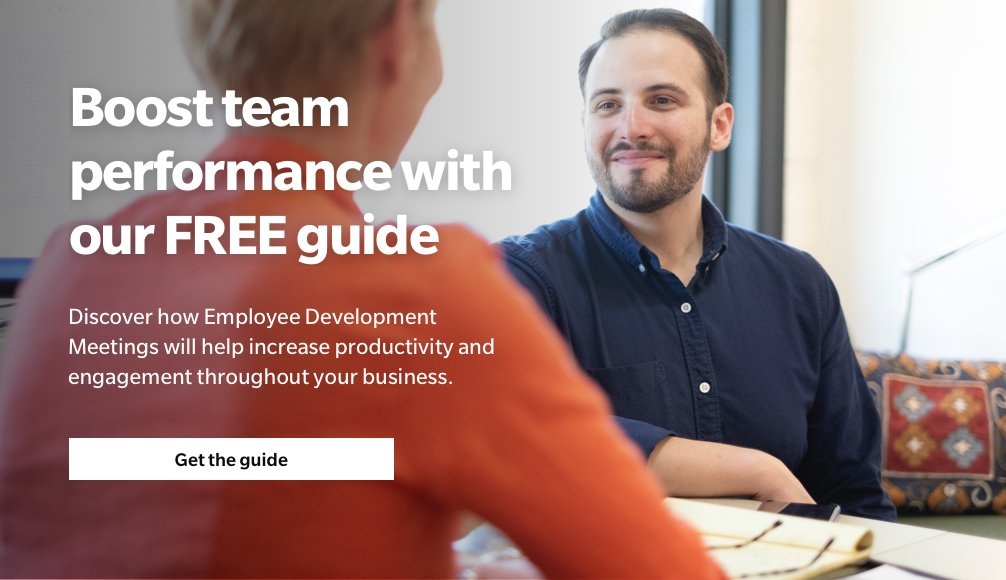Perhaps you know the famous proverb, “Give a man a fish and you’ll feed him for a day; teach a man to fish and you’ll feed him for a lifetime.” It may seem like an obvious concept, but it’s surprisingly hard for business owners to embrace. The essence of this idea speaks perfectly to why you owe it to both yourself and your team to develop leadership at your company: teach your people to lead, and you’ll free them to be independent (and less reliant on you). But the question remains: How do you develop leadership in your business? How do you help your people become the managers and leaders you need so that you can step away from your business, knowing that it’s in good hands? The good news is it’s not as hard as you think.
At EMyth, we believe that a strong Leadership System is an essential part of creating a business you love leading and a life you love living. Not only does it provide the fulfilling experience for your people that you promise them when you hire; it also gives you the ability to step away from your business and enjoy life with the full confidence that things are getting done your way. Maybe you find yourself in a business that’s entirely dependent on you, or trapped in a pattern of stagnancy and unable to scale up because you have no time to strategize. Whatever position you find yourself in, you likely need to develop your own leadership abilities in a way that also empowers your employees to manage effectively. Here are some of our favorite key concepts to get you started.
Hire with company values in mind
When small business owners come to us, we often find that they struggle to find and hire the right people. Not only is it an exhausting process—if your new hire ultimately leads to a bad fit, it can feel crushing. And without the right people, it seems nearly impossible to develop individuals into the managers you need. The most common reason behind this struggle is simple: Stop hiring people for their skill set alone and start hiring for culture. And if you don’t have your values and vision your company outlined, how are potential hires going to know if they’re aligned with them?
Start by identifying your personal core values, and then decide which ones translate to how you envision your business. From there, imagine how you want people to behave within your business. If teamwork is one of your key business values and a candidate prefers individual-oriented work, it’s not likely the right fit. So, with your business values in mind, craft an ideal candidate profile. Unlike a job description, this profile considers both skills and experience, but also personality traits, working style and the candidate’s personal values. It gives you something tangible to compare each job prospect to during your search and interview process—so you can be confident that when you hire, it’s for the right reasons. And as you train each new employee in your systems, you know they’re committed to your methods too.
Define your own way we do it here
When you’ve hired for culture, your team has unlimited potential. But to unlock that potential—and free yourself from the day-to-day work—you need to define and document your business systems so your people can get things done in the way you want them done. Every structural element of your business should be part of a larger strategy, and when your team leverages the systems to their greatest ability, they won’t need you every step of the way.
Being explicit on how you want things to be done in your business is never a bad thing—it gives your employees the structure and support to freely and independently work towards the results that they’re responsible for, all while leaning into your methods and values. You’ll also start to see them coming to you with creative solutions to new problems and changing circumstances. By investing this time and mentorship in people who are willing to do the work and embody your way we do it here, you’ll be rewarded with a stellar team of people ready to lead the next generation of your company.
Start fresh with an org chart
Before you can start developing leaders, you need to first assess the needs of your company and your team, then strategically lay out a plan for how the work flows. A healthy business ties tasks to systems, not people. And a well-thought out organization chart supports that goal. It identifies the functions and responsibilities needed to make your business run smoothly, and assigns them to specific positions. So instead of creating one complex, hybrid role for a particularly capable employee, you make sure every function sits within an appropriate position—and place the most suitable team member in that role. And if that person doesn’t exist, hire them (or decide if you really need them at the moment). By placing employees within the chart based on specific business activities—rather than their individual talents—everyone in the company will be able to see just how relationships and tasks should flow.
Forge working relationships that work
Strong leaders delegate out the Tactical Work in their business so that they can focus on leading the business. But this only works if there’s a strong balance between an important set of cultural values: open and respectful communication, honesty, accountability and trust. Consider these questions:
- Can you be open and honest with someone you don’t trust?
- Will your employees feel accountable to a goal if you don’t openly communicate with them about everything that may be impacting their work?
- Will someone trust you more if they feel you’re communicating with them respectfully?
You can’t focus these qualities on a single individual—you need to foster a workplace that embraces these values holistically, which means you may need to help cultivate them. And this may take some time.
Schedule Employee Development Meetings with your team
To set others up for success, you give each employee the chance to share how they're thinking and feeling. Employee Development Meetings (EDMs) are the perfect tool for this. Set up one-on-one meetings with individuals to check in on their role in general, and to evaluate the health of the relationships and functions within your company.
One-on-one EDMs create an open space where your employees (hopefully!) feel comfortable coming to you with a problem, and here’s an excellent teachable moment—rather than simply giving them an answer, collaborate and guide them to finding the solution themselves. They’ll have the satisfaction of getting support and problem solving tips that will boost their productivity, and by engaging authentically, you’ll have to worry less about micromanaging.
Form Position Agreements with your employees
If you’re like many of our clients, one of the biggest difficulties you face is a team of people who regularly fail to meet expectations. And often the source of this issue is not necessarily your employee's fault—it’s that your people simply might not fully know what's expected of them, or how they should be going about it. This is where Position Agreements can help. A Position Agreement is an important document that differs from a job description in that it’s a results-based document that identifies the activities and standards of each position—and it’s a contract that each employee and their direct manager agree on.
When it comes to fostering your people in leadership roles, the Position Agreement specifically includes those critical managerial responsibilities. It outlines not only where they sit within the company org chart and their responsibilities, but what positions and responsibilities they oversee. Without this mutual understanding in place—and well documented—your potential leaders won’t be quite sure how to start, and you won’t be sure of how to guide them.
Delegate with confidence
“But it’s easier to do it myself!” We hear that a lot—and we know the feeling. But delegation is essential to leadership—not just for yourself, but for your managers too. In a simple sense, delegation may seem like assigning tasks to another to perform; in reality, that’s more like abdicating responsibility. But effective delegation? It’s much richer.
When you manage a project and delegate the work to a team of employees, you don’t simply assign the tasks and never look back. You still retain ultimate accountability for the project, checking in on your employees along the way. Are they progressing? Are they meeting standards? Do they need support? Practice this with the leaders that you’re training up—hand off assignments or projects with a mutual understanding of the goals and timeline. Part of the challenge is finding the sweet spot between an abdicating (“I trust my employees so I don’t need to check in at all.”) versus the constant micromanaging (“How’s it going? Any updates?”). It’s an imperfect process at first. But ultimately, you’ll find your groove, improving employee satisfaction, productivity, accuracy and efficiency across the company.
The process of hiring and training leaders in your company can seem daunting. But think of it as an investment that benefits both you and your people. It’s more worthwhile to teach someone how to catch a fish, even if it takes a little longer than catching one yourself, because in the long run, you’ll spend a lot less time fishing. And that way, you can spend more time for yourself, maybe even on a boat.
Need help getting started? We’re here for just that reason.




Comments